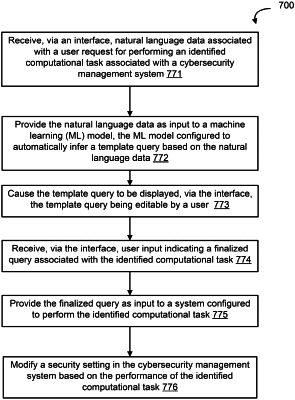| CPC G06F 21/57 (2013.01) [G06F 40/205 (2020.01); G06F 40/30 (2020.01); G06N 3/08 (2013.01); G06F 40/274 (2020.01); G06F 2221/034 (2013.01)] | 20 Claims |

|
1. A method, comprising:
receiving, via an interface, a natural language request for performing an identified task in a management system, the management system being associated with a set of system commands, the set of system commands being configured to perform one or more computational tasks associated with the management system, the identified task being from the one or more computational tasks, and the management system operating within an identified context;
extracting, based on the identified context, a set of features from the natural language request;
providing the set of features to a first machine learning (ML) model to infer a template command based on the natural language request, the first ML model trained using first training data, the first training data including a set of natural language phrases associated with the identified context, the first ML model trained to receive features based on the set of natural language phrases associated with the identified context as input, the template command being associated with the set of system commands;
receiving, as output from the first ML model, the template command associated with the natural language request;
displaying, via the interface, the template command in an editable form to be edited or approved by a user;
receiving, via the interface, a final command, based on the template command, the final command approved by the user;
providing the final command as a reference input to a second ML model, the second ML model configured to generate a set of natural language phrases semantically related to the reference input;
receiving, from the second ML model, the set of natural language phrases semantically related to the reference input;
generating a second training data based on the set of natural language phrases semantically related to the reference input;
augmenting the first training data by adding the second training data to the first training data to generate third training data; and
providing the final command to the management system to implement the identified task.
|